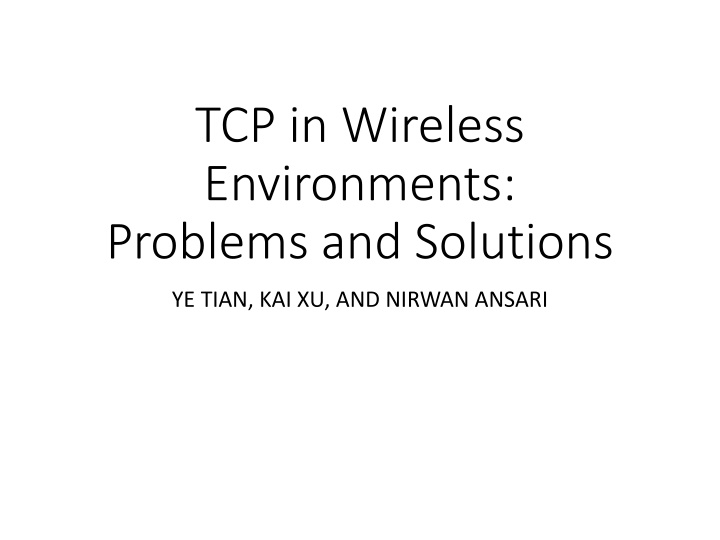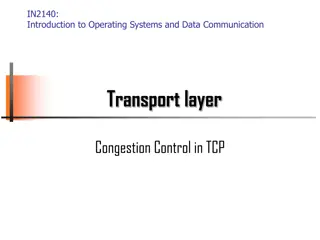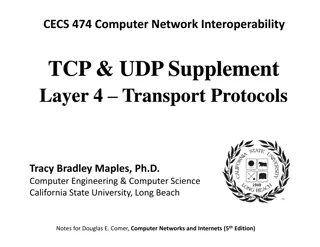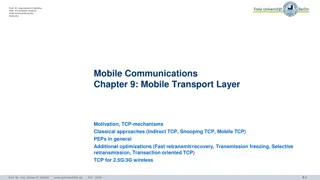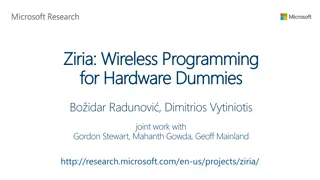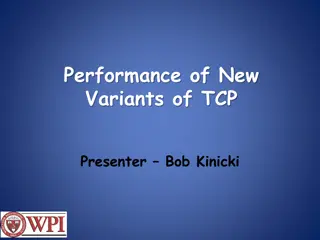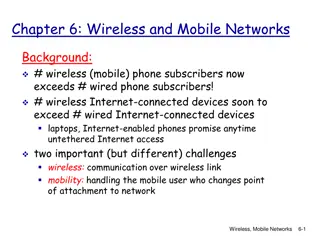TCP in Wireless Environments: Challenges and Solutions
TCP and IP in OSI architecture, problems in wireless environments, TCP packets, TCP Reno, challenges in heterogeneous networks with wireless links, urban obstacles, and mobility issues.
Download Presentation

Please find below an Image/Link to download the presentation.
The content on the website is provided AS IS for your information and personal use only. It may not be sold, licensed, or shared on other websites without obtaining consent from the author.If you encounter any issues during the download, it is possible that the publisher has removed the file from their server.
You are allowed to download the files provided on this website for personal or commercial use, subject to the condition that they are used lawfully. All files are the property of their respective owners.
The content on the website is provided AS IS for your information and personal use only. It may not be sold, licensed, or shared on other websites without obtaining consent from the author.
E N D
Presentation Transcript
TCP in Wireless Environments: Problems and Solutions YE TIAN, KAI XU, AND NIRWAN ANSARI
Introduction TCP and IP reside in the different layers of the open system interconnection (OSI) architecture IP Connectionless best-effort based variable length packet delivery network layer protocol reliable, timely, in-order delivery Routing mechanism based on the addressing scheme TCP layer four transport protocol that uses the basic IP services connection-oriented packet transport mechanism that ensures the reliable and ordered delivery of data
TCP packets Sequence number ACKs with sequence numbers of the next expected packets successfully received in-order packets Failures flow control and congestion control algorithms based on the sliding window and additive increase multiplicative decrease (AIMD) [1] algorithms
TCP Reno Slow start cwnd is increased by 1 MSS for every ACK received (grows exponentially in round-trip times) When cwnd reaches ssthresh, the TCP sender enters the congestion avoidance phase Congestion avoidance employs a sliding-window-based flow control mechanism CWND+=1/CWND upon reception of an ACK(linearly) Fast recovery/fast retransmit Reduces the size of its congestion window (cwnd) to half and linearly increases cwnd as in congestion avoidance
Challenges in the Heterogeneous Network Future all-IP networks will most likely be heterogeneous, but the TCP exhibits weaknesses in such hybrid environments Degradation of throughput, inefficiency in network resource utilization, and excessive interruption of data transmissions
Challenges in the Heterogeneous Network (cont.) Wireless links weather conditions, urban obstacles, multipath interferences, large moving objects, and mobility of wireless end devices much higher BERs limitations of radio coverage and user mobility require frequent handoffs temporal disconnections and reconnections between the communicating end hosts during a communication session
Challenges in the Heterogeneous Network (cont.) A short disconnection event can actually stall the TCP transmission for a much longer period
Challenges in the Heterogeneous Network (cont.) Multiple unsuccessful retransmissions within one RTT would cause the retransmission timer to exponentially back off
Challenges in the Heterogeneous Network (cont.) Link asymmetry A sender could mistakenly interpret a bad reverse channel condition as congestion on the forward channel and unnecessarily reduce the sending rate TCP performance degradation ACK compression effect The queuing in the reverse path of a TCP flow can cause the almost instantaneous arrival of successive ACKs at the sender end break TCP s self-clocking and cause long bursts of packet transmission in the forward direction, and thus possible congestive packet losses
Challenges in the Heterogeneous Network (cont.) Mobile wireless communications User mobility as well as limited radio frequency coverage of wireless devices, either base stations or terminals Handoff Wireless ad hoc network Infrastructurelessness and high node mobility of the network frequent route changes and network partitions Satellite network long propagation delay long-range transmission inefficient
TCP for Different Wireless Applications Satellite Networks Ad Hoc Networks Cellular Network
Satellite Networks Takes the sender of a TCP connection a fairly long time to reach a high sending rate during the traditional slow start phase TCP-Peach Sudden start (slow start) The reception of ACKs for the dummy packets indicates the availability of the unused network resource Dummy packets are labeled with low priority a router would drop the dummy packets first in the event of congestion Rapid recovery (fast recovery) Improve throughput in the presence of high link error rate The sender uses the lower-priority dummy packets to interleave the data packets and inflates the sending window size upon receptions of ACKs for the dummy packets
Ad Hoc Networks High error rate and frequent route changes and network partitions are typical ATCP Implemented as a thin layer inserted between the standard TCP and IP layers Explicit congestion notification (ECN) to detect congestion and distinguish congestion loss from error loss ICMP Destination Unreachable message to detect a change of route or temporary partition in an ad hoc network
Ad Hoc Networks (cont.) The ATCP layer puts the TCP sender into either the persist, congestion control, or retransmit state accordingly High BER - ATCP retransmits the lost packet so that TCP does not perform congestion control A route change or network partition - ATCP puts the TCP sender into the persist state waiting for the route to reconnect Packet reordering - ATCP reorders the packets so that TCP would not generate DUPACKs Real congestion - TCP enters the normal congestion control stage
Cellular Network Handoff and high BER Freeze-TCP Only requires code modifications at the mobile unit or receiver side The mobile unit has knowledge of the radio signal strength, and therefore can predict the impending disconnections In the presence of impending disconnection Receiver proactively sets the advertised window size to zero ceases sending more packets while keeping its sending window unchanged Reconnection - the transfer can resume quickly at the rate before the disconnection occurs
Implementation of Wireless TCP Split Mode Divides the TCP connection into wireless and wired portions, and ACKs are generated for both portions separately The performance on the wired portion is least affected by the relatively unreliable wireless portion End-to-End Approach Treats the route from the sender to the receiver as an end-to-end path
Split Mode Both end hosts communicate with the intermediate router independently without knowledge of the other end I-TCP The congestion window is maintained separately for the wireless and the fixed connections
End-to-End Approach Only the end hosts participate in flow control The receiver provides feedback reflecting the network condition, and the sender makes decisions for congestion control
End-to-End Approach (cont.) The ability to accurately probe for the available bandwidth is the key to better performance Minimum unused link capacity of the flow s fair share along the path Congestion control mechanism Reactive Congestion Control The sender rectifies the congestion window when the network situation becomes marginal or has crossed a threshold Proactive Congestion Control Feedbacks from the network guide the sender to reallocate network resources in order to prevent congestion
Reactive Congestion Control The congestion window is adjusted based on the collective feedback of ACKs and DUPACKs generated at the receiver continuously increasing the congestion window gradually until the network reaches the congestion state TCP fall back to a much slower transmission rate, which may be unnecessary for wireless random loss
Reactive Congestion Control (cont.) The fast recovery algorithm of Reno takes care of a single packet drop within one window New Reno The fast recovery mechanism does not terminate until multiple losses, indicated by the reception of partial ACKs, from one window are all recovered TCP SACK It indicates a block of data that has been successfully received and queued at the receiver when packet loss occurs instead of sending a partial ACK SACK requires modifications at the sender and receiver sides
Proactive Congestion Control Adjust the congestion window proactively to an optimal rate according to the information collected via feedback TCP Vegas Estimates the backlogged packets in the buffer of the bottleneck link Selects the minimal RTT as a reference to derive the optimal throughput the network can accommodate The difference between the optimal throughput and the actual sending rate can be used to derive the amount of backlogged data in the network Sets two thresholds of backlogged data
Proactive Congestion Control(cont.) TCP Veno Adopts the same methodology as Vegas to estimate the backlogged packets in the network Differentiate the cause of packet loss Below a threshold, the loss is considered to be random increases the congestion window in a conservative manner Above a threshold, the loss is congestive adopts the standard Reno scheme
Proactive Congestion Control(cont.) TCP Westwood Deploys an available bandwidth measurement module at the sender side based on the interval of returning ACKs Congested - sets the slow start threshold to reflect its estimated bandwidth-delay product Claims improved performance over TCP Reno and SACK while achieving fairness and friendliness Requires minimum modification at end hosts, and in some cases also the routers
Proactive Congestion Control(cont.) TCP-Jersey Available bandwidth estimation (ABE) - continuously estimates the bandwidth available to the connection and guides the sender to adjust its transmission rate when the network becomes congested Congestion warning (CW) - routers alert end stations by marking all packets when there is a sign of incipient congestion (ECN) Calculates the optimum congestion window size at the sender
Proactive Congestion Control(cont.) Proactive schemes, in general, exhibit the ability to handle random loss more effectively Proactive schemes are able to better distinguish random loss from congestive loss than reactive schemes
Summary Illustrating the typical wireless TCP techniques with examples It is difficult to make an overall conclusive evaluation of one solution vs. another
